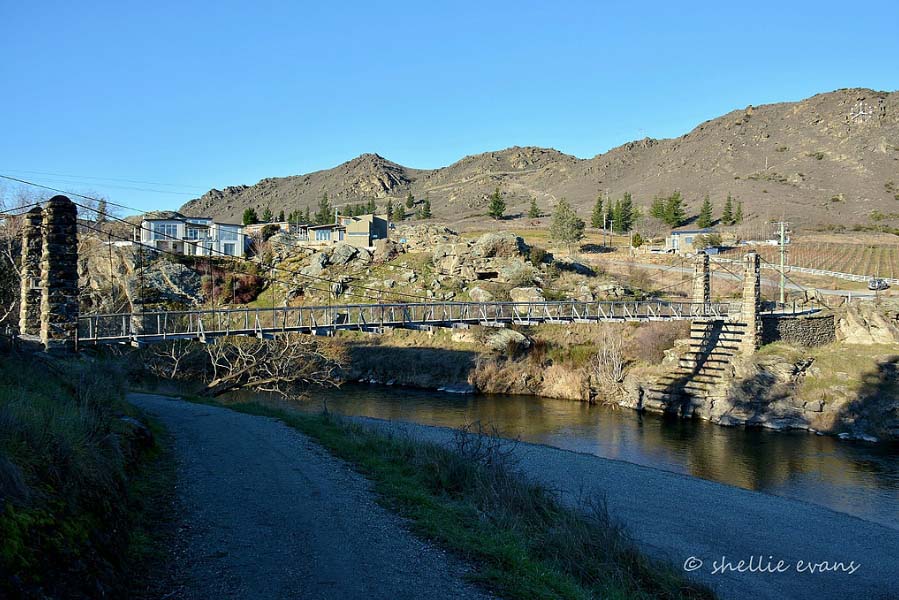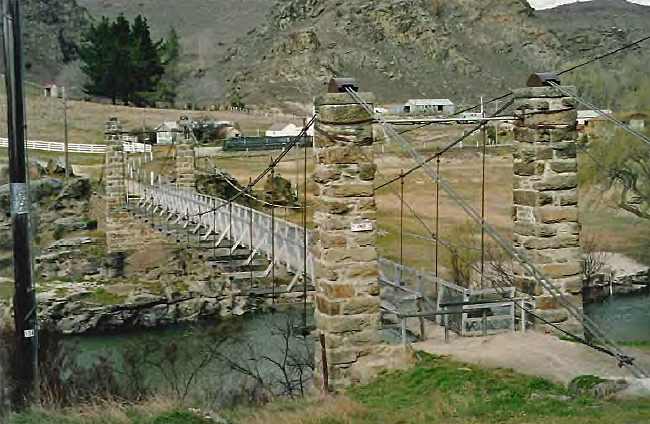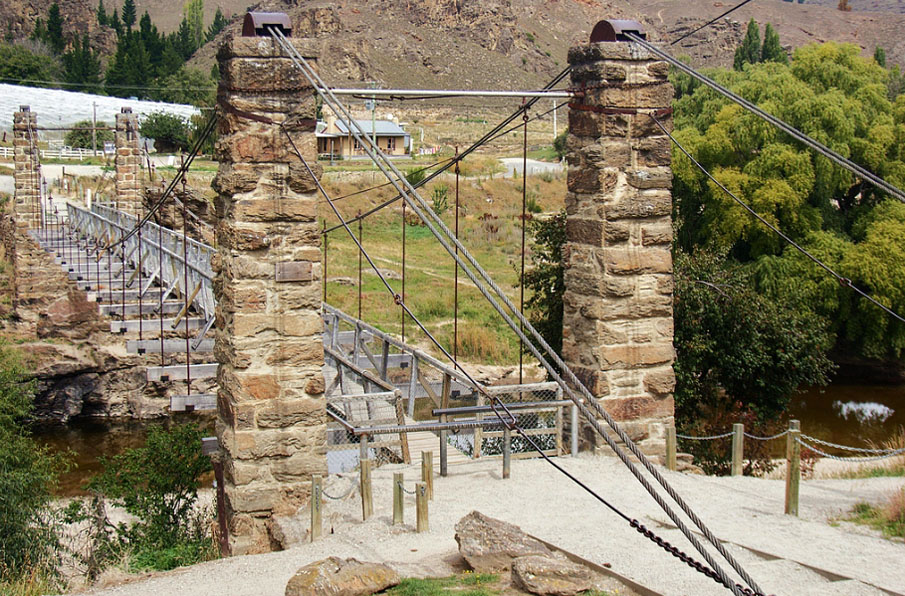Shaky Bridge crosses the Manuherikia River at Alexandra. It was completed in 1879 and provided a link between the growing town and the hinterland to the east of the Manuherikia and Clutha Rivers.
Alexandra is located at the confluence of the Clutha and Manuherikia Rivers. From the early 1860s the town was the centre of gold mining which continued with the dredging boom into the twentieth century. In February 1866 the town and adjacent lands were withdrawn from the goldfields (meaning that they were no longer covered by the special laws and regulations of a goldfield) and in 1867 the town was proclaimed a municipality. Alexandra was the commercial centre for some of Central Otago's large pastoral runs, such as Moutere and Galloway stations.
As Alexandra sits alongside two rivers, negotiating river crossings was an important concern for both travellers and townspeople. The first river crossings were made on foot or by horse, but people felt they were risking their lives, and establishing safe crossing was an early local concern. A crossing at the Manuherikia was proclaimed a punt site in May 1863. There was much local outrage because the tender for all the nine sites in Otago was granted to Henry Hill, giving him a virtual monopoly and putting other ferrymen out of business. Locals continued to use other ferrymen even though they were forbidden to cross within three miles of a proclaimed punt site.
Lobbying for a bridge over the Manuherikia at Alexandra began in the mid 1870s. In November 1876 the Tuapeka Times reported that a meeting had been held 'some time ago' to canvas support for a bridge. The Manuherikia River in flood cut all communication to the east of both the Manuherikia and the Clutha Rivers. Locals argued that a new bridge would provide a connection with the downstream settlements at Teviot over the Knobby Range. The cost of the proposed bridge was 'trifling' as the river was in a narrow gorge and would only require a small span. A committee was formed to gather information about potential costs, and to petition the Government, although they recognised that it was the County Council which would construct the bridge.
The Vincent County Engineer Leslie Duncan Macgeorge (variously spelt McGeorge, 1854-1939) drew up plans for the 'horse bridge' and surveyed the proposed site in June 1877. Geoffrey Thornton points out that the schist masonry towers of the Shaky Bridge were once a vernacular feature of Central Otago. The engineer, Macgeorge, Vincent County engineer at the time, was well known for his design of such suspension bridges. Similar schist piers also designed by Macgeorge are still in use on the Earnscleugh Bridge at Clyde (built 1874, Category II historic place, no. 2370). The small, elegant Daniel O'Connell Bridge at Ophir was also designed by MacGeorge (built 1880, Category I historic place, no. 338). Perhaps the most spectacular of Macgeorge's designs was the old Alexandra Bridge over the Clutha, also a suspension bridge (built 1882, Category I historic place no. 349).
By late 1877 members of the Alexandra community began to lobby for a 'traffic bridge'. Another committee was formed to investigate further, and a contractor (said at this time to be a Mr J. Drummy) provided an estimate of an extra £300 on top of the original tender price. In September 1877 supporters of the traffic bridge met to gauge public interest and in the following month a deputation went to the Council with the message that £135 had been subscribed with the view of getting a traffic bridge, and calling on the Council to meet that amount. James Colman, secretary of the Manuherikia Bridge Committee, wrote to the Vincent County Council in 1877 urging that a pack horse bridge be constructed over the Manuherikia at Alexandra. The Council agreed, and the Alexandra Borough Council promised a contribution of two thirds of the cost, provided this was not above £250.
The call for a bridge was not without controversy. In a letter to the Tuapeka Times a local queried the Council about the proposed bridge saying that the County Engineer had advised the Council that 'it was of no use erecting this bridge as it would not carry its own weight.' The writer considered the Council's acceptance of the tender of under £1000 was unreasonable, and reported that at the next Council meeting, a request was made for two extra wire ropes to strengthen the structure, but the engineer could not guarantee the structure even with the extra ropes, and the request was declined.
The tenders for a traffic bridge over the Manuherikia River were opened around January 1878. The amount of the tender was so much in excess of the sum voted that the Council postponed any decision, and it looked as though the locals would have to be content with a pack horse bridge as first proposed.
Grant and McKellar's tender of £974 10s for the traffic bridge was accepted, and the Council agreed to contribute £250. Concerts were held to raise money towards the council contribution. Construction was begun in June 1878 but there were delays. The Tuapeka Times hoped that by spring 'persons will be able to cross the river without risking their lives' and described several near fatal attempts to cross the river. The locals despaired, the paper reporting that having seen the contractors with materials on site, 'faint hopes are beginning to be felt that the present generation may yet see that structure completed.' In April 1879 the bridge was still under construction. The bridge was described as a 'light airy structure' which was a 'credit to the Engineer'. The transport infrastructure was becoming established, with several bridges over the Manuherikia, one under construction over the Clutha at Alexandra and the potential for a completed network when the Strath Taieri Railway made its way to Alexandra.
The bridge over the Manuherikia River at Alexandra is recorded as being completed without approaches in the Dunstan Times towards the end of April 1879. The approaches were not completed though, so the bridge was not open for traffic. The approach to the bridge on the south end was still around eight feet from the ground. In June 1879 the Council agreed to spend £150 on the approaches to the bridge and that the work be tendered for. In May 1880 the Tuapeka Times reported that the 'bridge over the Manuherikia river is all but completed, and is a handsome structure.' The paper also reported that an opening ceremony would be held funded by public subscription, and was likely to be a grand affair.
By the early 1900s the railway had almost reached Alexandra and the issuing of tenders for the construction of a joint road rail bridge over the Manuherikia River was imminent, and the bridge was completed by the end of 1906. The road rail bridge was located about 500m upriver from the old traffic bridge. This effectively made the structure redundant. The bridge was sold to Cameron and Moorhouse, local settlers across the river, for the nominal sum of £1.
Over time, the bridge fell into disrepair, earning the name 'Shaky Bridge'. When it seemed likely that Shaky Bridge (or Shakey Bridge as it was also written) would either fall down or be demolished, the local community formed the Pioneer Bridge Committee to preserve the stone piers as a monument to the early pioneers, and convert the bridge for use as a foot bridge. Local historian C.W. Moore states that £440 was raised by public subscription, with the Vincent County Council and Alexandra Borough Council each contributing £230, making the reconstruction of the bridge more expensive than its original costs. On completion of the restoration project in 1952 a plaque describing the bridge as a memorial to the pioneers of the region was fixed to one of the towers. Shaky Bridge has at several times over the intervening years almost been submerged in the flooding of the Manuherikia. Local sources indicate this level of flooding in both 1995 and 1999.
In 2001 a cottage on the true left of the Manuherikia River was converted into a café, named after the bridge which provides the link with Alexandra. In 2008 Shakey Bridge continues to provide pedestrian access over the Manuherikia River and is promoted as an attraction to tourists visiting the region.




